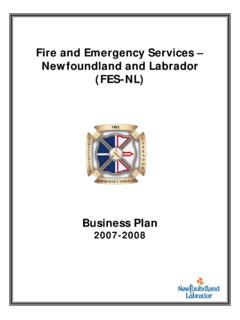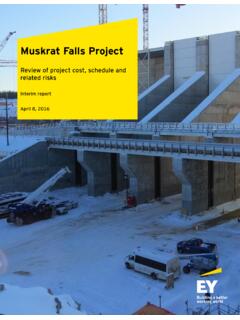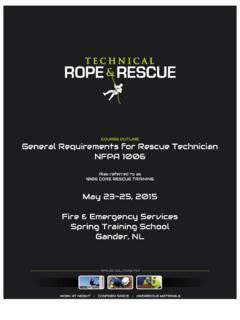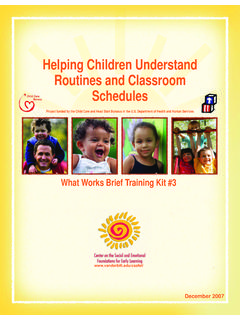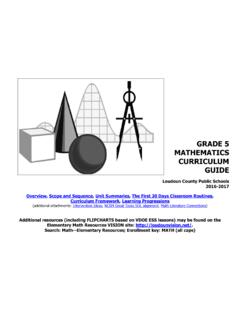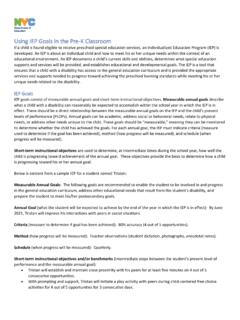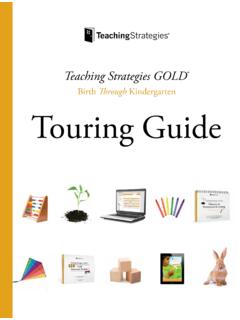Transcription of Classroom Design and Routines - Government of …
1 COMPLETELY KINDERGARTEN - KINDERGARTEN CURRICULUM guide - INTERIM EDITIONCLASSROOM Design AND ROUTINES23 Classroom Design and RoutinesCOMPLETELY KINDERGARTEN - KINDERGARTEN CURRICULUM guide - INTERIM EDITIONCLASSROOM Design AND ROUTINES24 Young children learn by doing and actively engaging with materials, equipment, and people in their learning environment. Creating a physical space that recognizes the developmental needs of five year olds provides a context in which optimal learning occurs. The choice and organization of Classroom materials in the learning environment influences the way in which a kindergarten teacher guides a student s development and sets the expectations for student engagement.
2 Beliefs about how children learn and the environment in which they work should complement one another. The physical Design of a developmentally appropriate Classroom allows for experiences in areas for reading, writing, listening, dramatic play, art, numeracy, block, science, technology and an area for large group meetings. Ensuring a balance amongst these various learning areas is an important component in the organization and planning of the physical space in a kindergarten Classroom . While classrooms may look different, the space should accommodate these learning areas so that children can learn to move independently throughout the room for the purpose of using the equipment and materials.
3 The physical environment should anticipate individual, small group, and whole group involvement that provides a balance between teacher and student-initiated activities. Movement experiences are essential for all kindergarten students and they should not be limited to the physical space in the Classroom or contained within discrete subject areas. Learning must be connected across the curriculum and the real world in meaningful ways while experiencing the outside world. This is possible by participating in field trips and extending the learning to areas such as the gymnasium, music room and the outdoors.
4 These learning areas do not have to be elaborate. Some of the best learning experiences grow out of trips in and around the school such as visiting another class to watch role plays, singing or poetry sharing, finding the signs on the rooms throughout the school, watching the snow plow clean the street, observing a bird eating from a birdfeeder, examining playground equipment, observing falling leaves, walking across the street to a wharf, a general store or a supermarket and picking flowers to give to a sick friend. The experience should allow for participation, close up viewing/observation, touching and questioning within the child s level of thinking and reasoning while reinforcing, extending and enriching a student s Physical Space COMPLETELY KINDERGARTEN - KINDERGARTEN CURRICULUM guide - INTERIM EDITIONCLASSROOM Design AND ROUTINES25 Throughout the school year, learning areas will change to reflect children s interests, learning outcomes, projects and themes.
5 Key learning areas such as reading, writing, listening, math and science may operate throughout the kindergarten year while other areas may rotate based on curriculum expectations. Kindergarten children should be provided large blocks of time daily to be involved in learning activities within these areas. This may include a system of rotation which provides children the opportunity to make decisions on their own learning based on the specified learning areas. It is important to introduce materials gradually in the learning areas and to give children time to become familiar with the materials to understand their purpose.
6 The teacher needs to ensure that children do not roam aimlessly from area to area or visit the same area exclusively. The organizational structure and daily Routines of the Classroom should make children feel safe while supporting and encouraging them to take risks and to work cooperatively with others to become confident and independent learners. The kindergarten teacher circulates to observe and document children s learning as they are involved in learning activities. Some of the activities may require direct teacher involvement and instruction through questioning and scaffolding.
7 Consideration to the materials displayed throughout the room is necessary in the Design of the physical space of the Classroom . Displays which clutter student s learning spaces should be avoided. An aesthetically pleasing environment celebrates and values children s work by including displays of their work. This allows the kindergarten child to feel valued for his/her contributions to the learning environment in which he or she belongs. Overcrowded walls cause much work for the teacher and too much stimulation for students. Less is often more.
8 COMPLETELY KINDERGARTEN - KINDERGARTEN CURRICULUM guide - INTERIM EDITIONCLASSROOM Design AND ROUTINES26 Consider the idea of dividing the Classroom into areas for wet, dry, active, quiet, clean and messy activities. Place similar areas within close proximity of each other. For example, a block area and a dramatic play area are active areas which could be placed near each other whereas a reading area would need a more quiet space. Arrange materials in each area which can be easily accessed by children. Use baskets, bins, and drawers for storage and label them at a child s eye-level.
9 Use furniture to define space and create boundaries for specific areas. A rug defines space and reduces noise. Place block areas and dramatic play areas in corners. Utilize wall space to display children s work rather than commercial materials. Display work at the children s eye level. Include floors, tables, walls and other areas in and around the Classroom for workspace. Add materials to areas gradually as needed rather than overwhelming with too much at once. Eliminate unnecessary materials. Place areas requiring clean up in close proximity to a water source with available materials for children to access and to assist with clean up.
10 Some areas may require close proximity to a storage space for brushes and paints. Create interactive areas that promote oral language development by positioning structures such as art easels beside each other so that children can interact and share while engaging in a similar activity. Vary the amount of space required for each area depending on the materials being used. For example, the block area will require a larger area for building structures. Establish the Classroom Design to ensure Routines for courtesy, safety, and clean up. Take advantage of natural light where possible.

